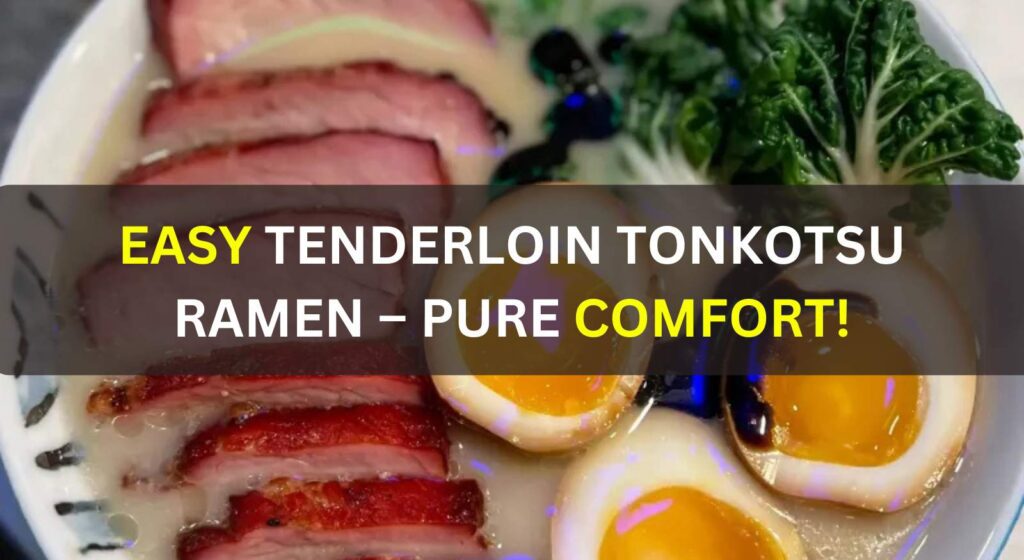A Perfect Bowl at Home
Making tonkotsu ramen at home has been a passion of mine for the past 2 years, filled with testing, tinkering, and fine-tuning the recipe to get that perfect balance of taste and effort. While traditional ramen can be a long process, I’ve found some smart shortcuts that save time without sacrificing flavor. The result is an incredible combination of homemade and premade ingredients that come together to produce one of my favorite meals.

What makes my bowl stand out is the non-traditional choice of pork tenderloin as a topping, adding a unique twist while keeping the essence of this comforting dish. I’m always delighted when I can work in techniques that enhance the dish effortlessly. Whether you’re new to ramen or a longtime fan, this recipe brings everything you need for a rich, flavorful experience in one satisfying bowl.
FAQ
What’s in Tonkotsu Ramen?
Tonkotsu ramen is known for its incredibly rich and creamy broth, made from pork (and sometimes chicken) bones. This slow-cooked bone broth creates the signature texture and deep umami flavor. A classic bowl is topped with chashu, a flavorful preparation of pork belly, along with soy-marinated soft-boiled eggs that add a perfect balance.
Many enjoy adding black garlic oil, which, despite its name, comes from burnt garlic and enhances the depth of the dish. Garnishes like green onion, baby bok choy, bamboo shoots, pickled ginger, and wood ear fungus bring freshness and crunch, making every spoonful an exciting combination of textures and flavors.
What’s the Difference Between Tonkotsu Ramen and Regular Ramen?
When people think of “regular” ramen, they usually imagine shoyu ramen, which has a soy sauce-based broth. In contrast, tonkotsu ramen is made by simmering pork (and sometimes chicken) bones for hours, creating a thick and creamy bone broth. This results in a richer and more intense flavor compared to the lighter, clear shoyu variety.
Why is Tonkotsu Ramen Creamy?
Many assume the creamy texture of tonkotsu ramen comes from dairy, but it actually comes from the slow-cooked pork bones. During cooking, the fat and collagen in the bones break down and become emulsified into the soup, creating the signature thick, silky broth that makes tonkotsu so satisfying.
Is Tonkotsu Ramen Healthy?
While tonkotsu ramen is incredibly flavorful, its broth tends to be high in calories and sodium, making it something best enjoyed in moderation. However, since it’s a bone broth, it also offers benefits like collagen, essential amino acids, vitamins, and minerals, which are great for overall health.
How is Tonkotsu Ramen Broth Made?
Instead of spending 24+ hours making homemade tonkotsu stock, I rely on a high-quality premade tonkotsu broth that delivers the same depth of flavor. This allows me to focus my energy on perfecting the toppings, ensuring every bowl of ramen is as delicious as possible without the lengthy process.
Crafting tonkotsu from scratch is truly a labor of love. It begins with sourcing pork bones, such as pig trotters, pork neck bones, and pork leg bones, which can sometimes be tricky to find—your best bet is an Asian market. The bones are first placed in cold water and brought to a rolling boil. After this initial boil, the pot is drained, and the bones are thoroughly cleaned to ensure a smooth, impurity-free broth. Next, aromatics like garlic and ginger are charred, adding deep, roasted flavors before everything is combined in a pot for a long simmer. During this stage, continuously skimming scum from the surface with a slotted spoon keeps the broth clear and pure.
To develop the signature pork bone broth, the mixture must be left to simmer at a low boil for about 12 hours. After this long process, the soup is carefully passed through a fine mesh strainer, and any excess pork fat is removed from the top. The result is a creamy white broth, which can be enhanced further with soy sauce, miso, or other flavors to taste. While this is the traditional approach, some modern tonkotsu ramen recipes simplify the process with a pressure cooker or sous vide, making it more accessible for home cooks.
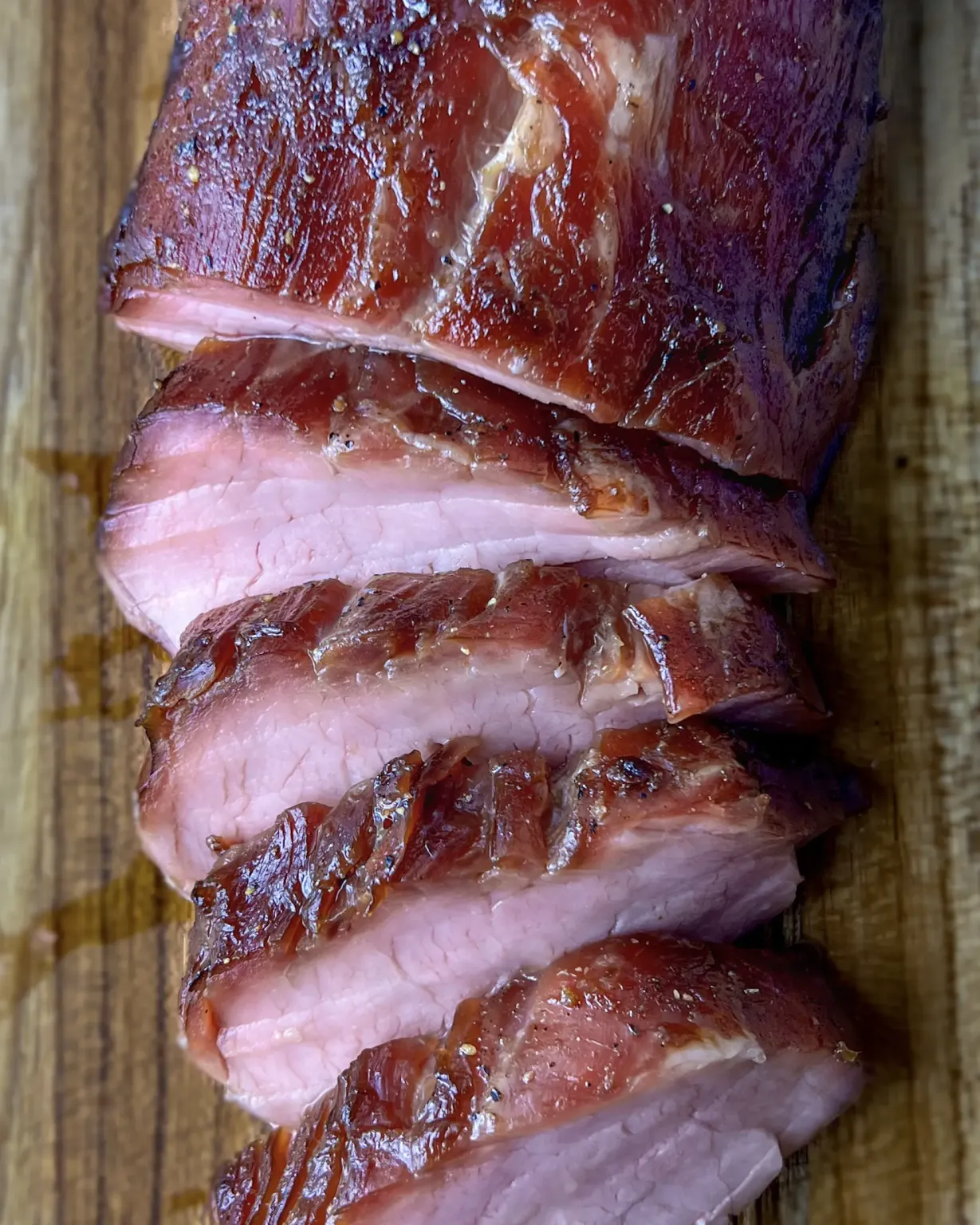
My Take on Tonkotsu Ramen
One of the biggest ways I personalize tonkotsu ramen is by swapping out the traditional chashu pork belly for pork tenderloin. While pork belly is rich and fatty, I find that pairing it with an already creamy broth can be overwhelming. Instead, pork tenderloin is a lean cut that, when prepared correctly, remains incredibly tender. Some may worry that it will overcook when sitting in the hot soup, but I’ve never had that issue—it holds up beautifully in the bowl.
For both the broth and noodles, I opt for premade ingredients because I’ve found such high-quality options that making them from scratch is unnecessary. Traditional homemade tonkotsu broth takes over 24 hours to prepare, but brands like Somi and Kikkoman offer tonkotsu broth that rivals what I’ve had in restaurants—and they take only minutes to make.
The same goes for premium frozen ramen noodles; they surpass anything I could make myself and are even better than some restaurant-quality offerings. If these ingredients are available in your area, I highly recommend them—they make an authentic bowl possible without the extensive time commitment.
Since using shortcuts for these elements frees up time, I can focus on making black garlic oil, which is nearly impossible to find in the U.S., and preparing marinated eggs fresh. However, I don’t always make this dish the same way. With broth and noodles ready to go, I often throw together a quick bowl on a busy weeknight, skipping the black garlic oil and marinated eggs when I don’t have time. Sometimes, I even use precooked pork tenderloin from my freezer, making this a complete meal in just 10 minutes. The flexibility of this approach means I can enjoy a comforting bowl of tonkotsu ramen anytime, without the long prep.
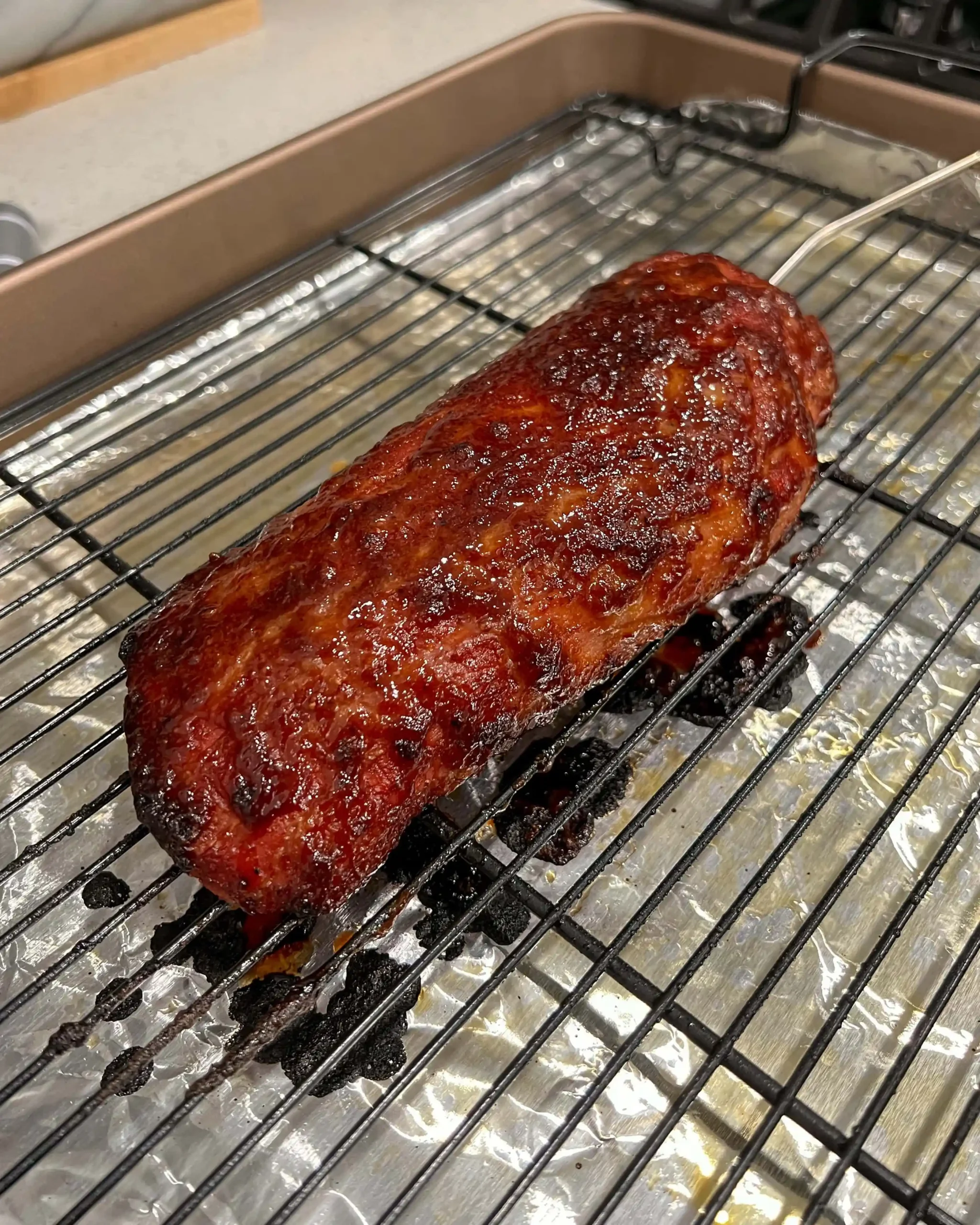
Key Tips – Tenderloin Tonkotsu Ramen
Each key ingredient in this tonkotsu ramen recipe plays a crucial role, and there are a few great substitutions to consider!
Hoisin Glazed Pork Tenderloin or Smoked Pork Tenderloin
When it comes to pork tenderloin, I have two go-to preparation methods: Hoisin Glazed Pork Tenderloin, made in the oven, or Smoked Pork Tenderloin, cooked in a smoker. The amount of meat per bowl is entirely up to preference—a 1 lb raw pork tenderloin typically yields 12 oz of cooked pork, which can be divided between 2 to 4 bowls of ramen. In the pictured version, each bowl has about 6 oz of cooked pork.
While pork belly is the traditional choice for tonkotsu ramen, I prefer pork tenderloin because it’s easy to prepare and leaner. Some worry that a lean cut like tenderloin might overcook in the warm broth, but I’ve always been satisfied with the results—it stays tender and delicious every time!

Frozen Premium Ramen Noodles
I’ve tested every kind of ramen noodle imaginable—homemade, dried, and instant—but nothing beats premium frozen ramen noodles from a Japanese grocery store. These noodles are as close as you can get to fresh ramen noodles, and they rival those from high-end ramen shops. Plus, they’re incredibly easy to prepare at home.
That said, they can be hard to find if you don’t have an Asian market nearby, and they are on the pricier side, typically costing $8–$10 for a pack of five servings. If they aren’t an option, consider making your own (many recipes are available online), purchasing high-quality dried noodles, or using instant ramen noodles, which are widely available at most grocery stores.

Tonkotsu Ramen Broth from Concentrate
Making tonkotsu ramen broth from scratch is a time-consuming process that requires at least 24 hours and access to pork bones, which can be hard to find. While there are many recipes available online, I’ve found that some premade concentrates are actually better than many restaurant versions and serve as a great shortcut for making delicious ramen at home.
My top choice is Somi Tonkotsu Soup Base, followed closely by Kikkoman Tonkotsu Soup Base. Both come in a 1 kg (~35 oz) XL bag, and 1 oz of concentrate is diluted to create 1 cup of soup. Since I use 2 cups per XL bowl, each bag makes about 17 bowls of ramen. However, I typically use 5 oz (½ cup) per 4 cups of soup, which brings my yield to about 14 bowls per bag. Depending on availability, these bags range from $25 to $40, making each bowl of ramen cost around $2 to $3.
The broth concentrate is shelf-stable and only needs refrigeration after opening. I’ve kept re-sealed bags in my fridge for months with no issues. Since the Somi bag is not resealable, I use bag sealing sticks to keep it airtight. I also tried freezing the concentrate, hoping it would set, but it didn’t freeze solid.
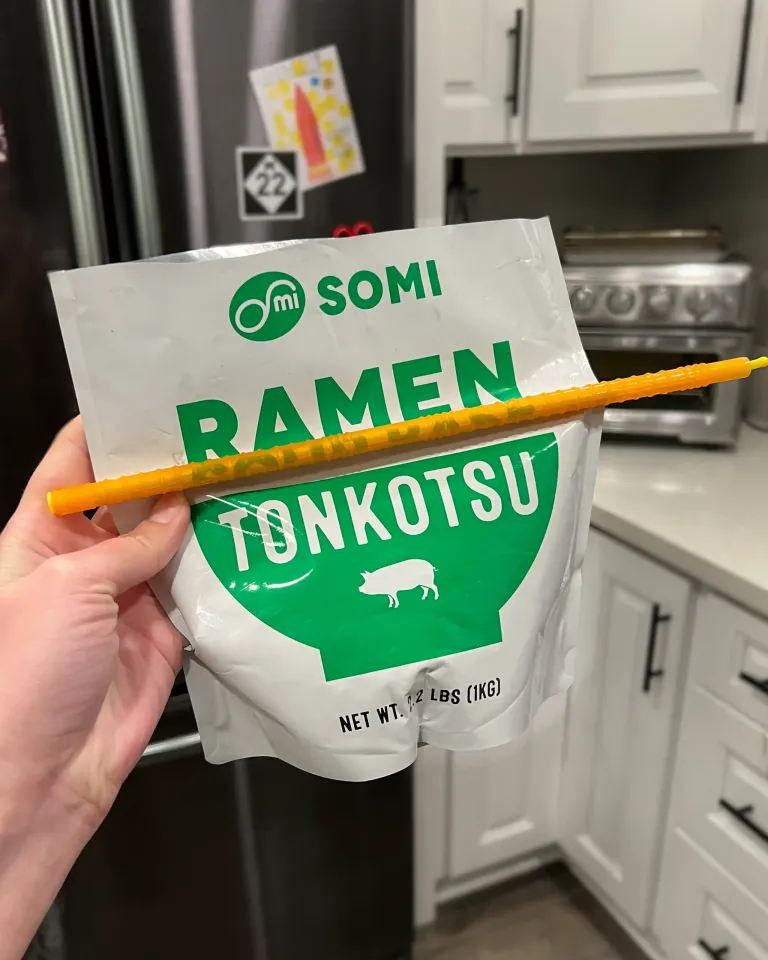
Soy Marinated Eggs for Ramen (Ajitama)
For me, no bowl of ramen is complete without a marinated egg! The egg is hands-down my favorite part of the bowl. My soft-boiled eggs are marinated for about one day in a soy sauce-based marinade, giving them a rich, umami flavor. These eggs are perfect for serving with my Tenderloin Tonkotsu Ramen, enhancing instant ramen, or even pairing with a simple bowl of rice.
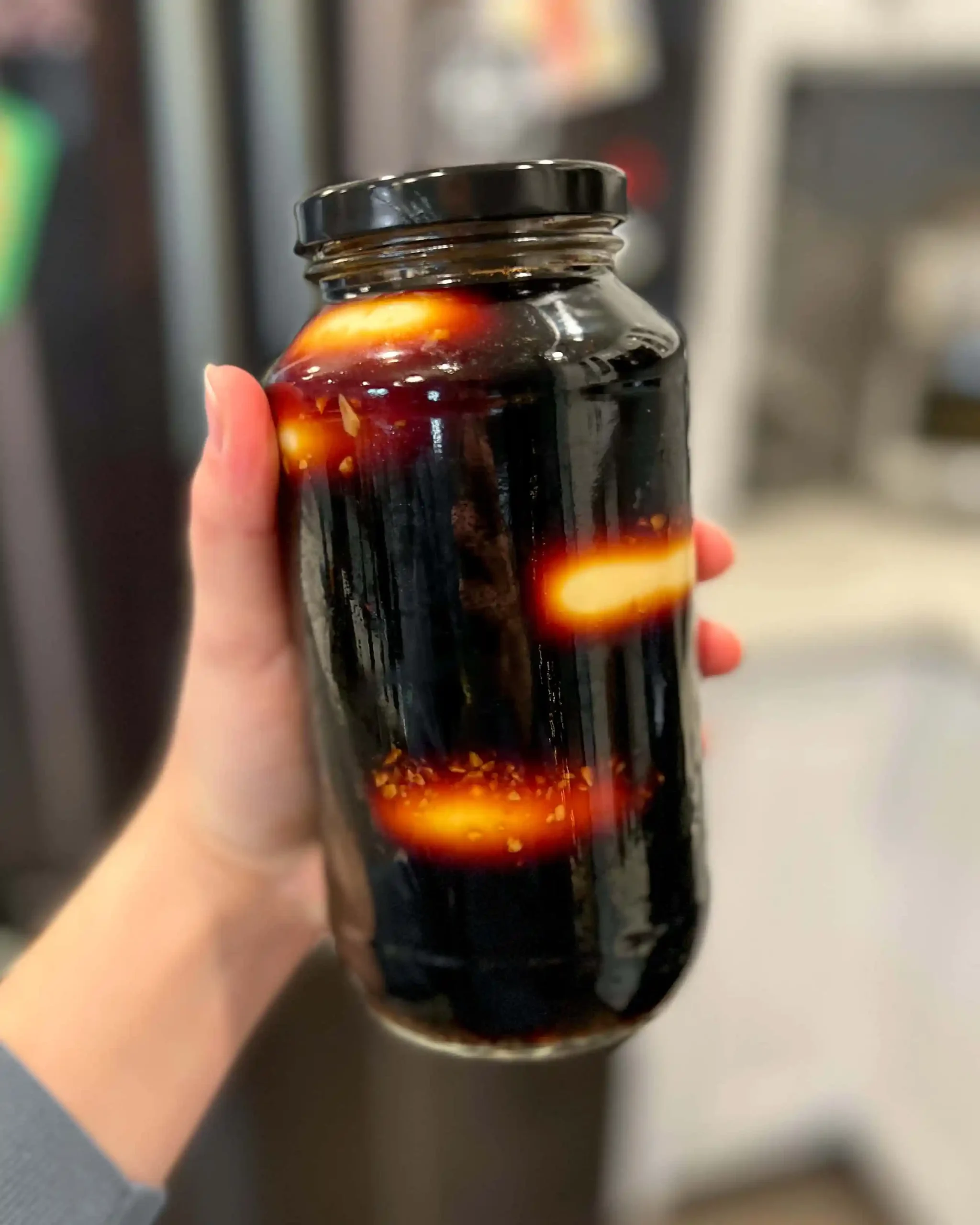
Black Garlic Oil for Ramen (Mayu)
A standout topping for tonkotsu ramen, black garlic oil—known as mayu in Japanese—adds an extra layer of depth and flavor. The English name is a bit misleading, as this oil is not made from black garlic but rather from burnt garlic. The process is simple, requiring just a few ingredients, but the flavor is incredible.
More Topping Ideas for Tonkotsu Ramen
Beyond the soy marinated soft-boiled egg and black garlic oil, there are plenty of other delicious toppings that can take your tonkotsu ramen to the next level. For a fresh kick, try green onions or pickled ginger. If you love a bit of crunch, add bean sprouts, bamboo shoots, or wood ear mushrooms.
For a richer umami flavor, shiitake mushrooms, minced garlic, and nori sheets are excellent choices. If you enjoy some heat, a drizzle of chili oil or a spoonful of chili crisp will do the trick. You can even sprinkle in some sesame seeds or add fish cakes for a more authentic touch.
Dietary Restrictions – Pork Tenderloin Tonkotsu Ramen
This dish is naturally dairy-free, making it a great choice for those who avoid dairy products.

A Note on Serving Sizes
Portion sizes can be tricky since everyone has different appetites. This recipe makes two XL bowls of ramen, as pictured, but it can also be divided into three to four smaller portions if you prefer a lighter meal.
✨ Easy Tenderloin Tonkotsu Ramen Recipe ✨
A rich and creamy Japanese tonkotsu ramen with tender pork tenderloin, topped with flavorful soy-marinated eggs and aromatic black garlic oil! 🍜
📌 Recipe Details
- Prep Time: 10 minutes ⏳
- Cook Time: 20 minutes 🍳
- Total Time: 30 minutes 🕒
- Cuisine: Japanese, American 🇯🇵🇺🇸
- Course: Main Course 🍽️
- Servings: 2 XL Bowls 🍜🍜
- Calories: ~800 kcal 🔥
🌟 Ingredients
🥩 Choose One Tenderloin Option:
✅ 8-12 oz Hoisin Glazed Pork Tenderloin (baked) – prepared per linked recipe ✅ 8-12 oz Smoked Pork Tenderloin – prepared per linked recipe
🍜 Other Ingredients:
✅ 2 Soy Marinated Eggs (Ajitama) (optional, prepared per linked recipe) ✅ 1-2 tbsp Black Garlic Oil (Mayu) (optional, prepared per linked recipe) ✅ ½ cup Somi or Kikkoman Tonkotsu Broth Concentrate (or 4 cups of prepared tonkotsu broth) ✅ 2 blocks (200 g each) Frozen Ramen Noodles (sub with homemade or dried noodles) ✅ 2 Green Onions (thinly sliced) ✅ 2 Baby Bok Choy (optional)
🔥 Instructions
📌 Step 1: Prepare the Ingredients
- If using Hoisin Glazed or Smoked Pork Tenderloin, cook per linked recipe.
- If using Soy Marinated Eggs, prepare them at least one day ahead.
- If using Black Garlic Oil, prepare in advance or make fresh.
📌 Step 2: Make the Broth
- In a medium saucepan, combine ½ cup of tonkotsu broth concentrate with 4 cups of water.
- Bring to a gentle simmer to warm through.
- If using a different concentrate, check the ratio and prepare ~4 cups of soup.
📌 Step 3: Prepare the Noodles
- Bring a large pot of water to a boil.
- Cook premium frozen ramen noodles for 1-2 minutes (or as per package instructions).
- Transfer directly to serving bowls.
📌 Step 4: Prepare the Baby Bok Choy (Optional)
- Raw Method (Preferred): Slice off the base, separate leaves, rinse well, and place in bowls.
- Cooked Method: Boil for 1-2 minutes until softened, then place in serving bowls.
📌 Step 5: Assemble Your Ramen!
- Pour the hot tonkotsu broth over the noodles.
- Slice the marinated eggs in half and place in the bowl with the yolk facing up.
- Add sliced pork tenderloin on top.
- Sprinkle with green onions and a drizzle of black garlic oil.
🌿 Topping Ideas
Want to customize your ramen? Try adding:
- Green onions (spring onions) 🌱
- Baby bok choy 🥬
- Wood ear mushrooms 🍄
- Bamboo shoots 🎋
- Minced garlic 🧄
- Bean sprouts 🌱
- Nori sheets (seaweed) 🟩
- Chili oil / Chili crisp 🌶️
- Pickled ginger 🍥
- Sesame seeds
💡 Key Tips & Notes
✅ Meal Prep:
- The eggs should be made a day ahead.
- The black garlic oil can be made in advance.
✅ Ingredient Substitutions:
- No frozen ramen? Use dried ramen noodles or instant ramen noodles.
- Can’t find tonkotsu broth concentrate? Use chicken broth with miso paste as a substitute.
✅ Serving Sizes:
- This recipe makes 2 XL bowls (as pictured) but can be split into 3-4 smaller servings.
🍜 Enjoy your homemade Tenderloin Tonkotsu Ramen! 🍜
👨🍳 Happy Cooking! 🥢

